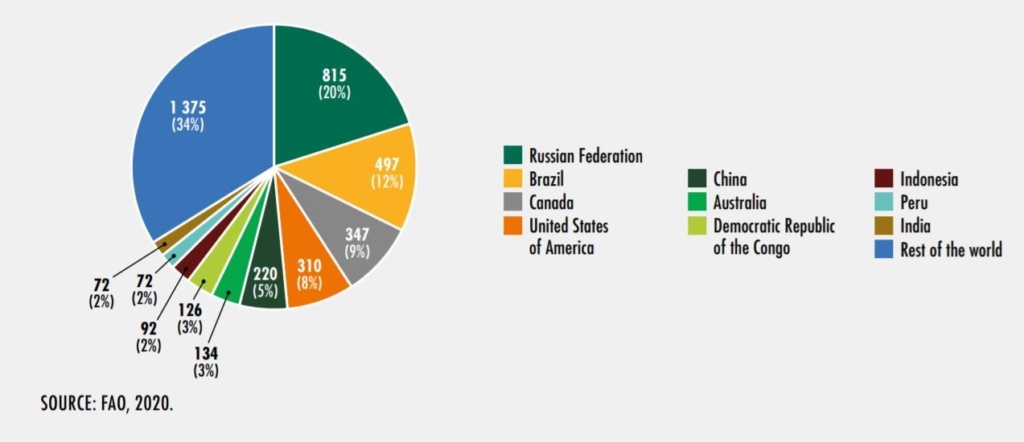Even more, than five months after the novel coronavirus was discovered in China, the world is still reeling under the many challenges of the COVID-19 pandemic. While the immediate global priority is to tackle this public health emergency, our long-term response must also address the underlying causes of such a pandemic. The degradation and loss of forests is one such contributing factor, disrupting nature’s balance and increasing the risk and exposure of people to zoonotic diseases.
This year marks the end of the United Nations Decade on Biodiversity 2011–2020 and countries are preparing to adopt a post-2020 global biodiversity framework. Understanding and keeping track of the state of our world’s forests has never been so important.
Forests cover 31 per cent of the global land area but are not equally distributed around the globe. The total forest area is 4.06 billion hectares. More than half of the world’s forests are found in only five countries (Brazil, Canada, China, the Russian Federation and the United States of America). India possesses only 2% of the world’s forest cover, according to the 2020 FAO data.

Forests, Food Production and Consumption
Forests supply water, mitigate climate change and provide habitats for many pollinators, which are essential for sustainable food production. It is estimated that 75 per cent of the world’s leading food crops, representing 35 per cent of global food production, benefit from animal pollination for fruit, vegetable or seed production.
Feeding humanity and conserving and sustainably using ecosystems are complementary and closely interdependent goals. We need to transform our food systems to halt deforestation and the loss of biodiversity. The biggest transformational change is needed in the way in which we produce and consume food.
Forests have an essential role in the maintenance of biodiversity as a gene pool for food and medicinal crops. With climate change exacerbating the risks to food systems, the role of forests in capturing and storing carbon and mitigating climate change is paramount.
Forests, Human Health and Risks
Human health and well-being are closely associated with forests. More than 28,000 plant species are currently recorded as being of medicinal use and many of them are found in forest ecosystems. Forest environments can have positive impacts on human physical and mental health and many people have a deep spiritual relationship to forests. Yet, forests also pose health risks. Forest-associated diseases include malaria, Chagas disease (also known as American trypanosomiasis), African trypanosomiasis (sleeping sickness), leishmaniasis, Lyme disease, HIV and Ebola. The majority of new infectious diseases affecting humans, including the SARS-CoV2 virus that caused the current COVID-19 pandemic, are zoonotic and their emergence may be linked to habitat loss due to forest area change and the expansion of human populations into forest areas, which both increase human exposure to wildlife.
Forests and Sustainable Development Solutions
Ensuring positive outcomes for both biodiversity and people requires a careful balance between conservation goals and demands for resources that support livelihoods. Solutions that balance conservation and sustainable use of forest biodiversity are critical – and possible. Not all human impacts on biodiversity are negative, as shown by the many concrete examples of recent successful initiatives to manage, conserve, restore and sustainably use forest biodiversity in the 2020 State of the World’s Forests report. It also includes a number of case studies of innovative practices that combine conservation and sustainable use of forest biodiversity to create balanced solutions for both people and the planet.
Conservation Goals Vs. Human Livelihood
There is an urgent need to ensure that biodiversity conservation is mainstreamed into forest management practices in all forest types. To do so, a realistic balance must be struck between conservation goals and local needs and demands for resources that support livelihoods, food security and human well-being. This requires effective governance; policy alignment between sectors and administrative levels; land-tenure security; respect for the rights and knowledge of local communities and indigenous peoples; and enhanced capacity for monitoring of biodiversity outcomes. It also requires innovative financing modalities.
It’s Time #ForNature
The COVID-19 outbreak has underscored the fact that, when we destroy biodiversity, we destroy the system that supports human life. No wonder then that World Environment Day 2020 has called for urgent action to protect biodiversity – with its tagline, this year’s theme – “Time for Nature.” Large-scale forest restoration is needed to prevent, halt and reverse the loss of biodiversity. Forest restoration, when implemented appropriately, helps restore habitats and ecosystems, create jobs and income and is an effective nature-based solution to climate change.
Let’s hope that this year’s World Environment Day celebrations will help build momentum and unite everyone in conserving the natural world, for it would be impossible for us to survive without nature’s services.


Generic Amoxil Oral Drops